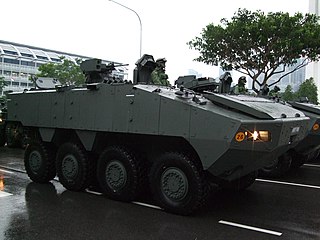
The Buffel is an infantry mobility vehicle used by the South African Defence Force during the South African Border War. The Buffel was also used as an armoured fighting vehicle and proved itself in this role. It replaced the older Bedford RL-based Hippo APC and itself was replaced by the Mamba from 1995 in South Africa, but remains in use elsewhere, notably Sri Lanka.

The Terrex Infantry Carrier Vehicle (ICV) is an armoured fighting vehicle (AFV) developed by ST Engineering of Singapore and Timoney Technology of Ireland, and produced by ST Engineering Land Systems for the Singapore Army as well as by Turkish auto-maker Otokar as the Yavuz (AV-82) for the Turkish military.

The BTR-40 is a Soviet open-topped, wheeled armoured personnel carrier and reconnaissance vehicle. It is often referred to as the Sorokovka in Soviet service. It was eventually replaced in the APC role by the BTR-152 and in the scout car role by the BRDM-1.
Talha is an armoured personnel carrier (APC) designed and manufactured in Pakistan by APC Factory of Heavy Industries Taxila (HIT).
A huge number of M113 Armored Personnel Carrier variants have been created, ranging from infantry carriers to nuclear missile carriers. The M113 armored personnel carrier has become one of the most prolific armored vehicles of the second half of the 20th century, and continues to serve with armies around the world in many roles.

The Dragoon 300 AFV was produced by Arrowpointe Corporation during the 1980s. It was based on the automotive components of the United States Army's M113 APCs and 5-ton trucks. It resembles a larger V-150 Commando.

Otokar Otomotiv ve Savunma Sanayi A.Ş., also known simply as Otokar, is a Turkish bus and military vehicle manufacturer headquartered in Sakarya, Turkey. Otokar is a subsidiary of Koç Holding.

The Panhard M3 VTT is an amphibious armoured personnel carrier. Developed as a private venture for the export market, the M3 was built with the same mechanical and chassis components as the Panhard AML range of light armoured cars. The two vehicle types share a 95% interchangeability of automotive parts. The M3 is an extremely versatile design which can be configured for a wide variety of auxiliary battlefield roles. The most popular variants of the base personnel carrier included an armoured ambulance, a mobile command post, and an internal security vehicle. It could also be fitted with a wide variety of turrets and armament, ranging from a single general-purpose machine gun to medium calibre autocannon.

The D-442 FUG and D-944 PSZH are the results of Hungarian domestic development of relatively cheap amphibious armoured scout car and armored personnel carrier series. FUG and PSZH were exported with limited success, thus it is also known under its Czechoslovak designation OT-65.

The OT-62 TOPAS is a series of amphibious tracked armoured personnel carriers developed jointly by Polish People's Republic and Czechoslovakia (ČSSR). OT-62 stands for Obrněný Transportér vzor 62 – "armoured personnel carrier model 62". TOPAS stands for Transportér Obrněný Pásový – "tracked armoured personnel carrier".

The Anoa is a 6x6 armoured personnel carrier developed by PT Pindad of Indonesia. The vehicle is named after the Anoa, which is a type of buffalo indigenous to Indonesia. The prototype was first unveiled at the 61st anniversary of TNI on October 5, 2006, in TNI HQ at Cilangkap, east of capital Jakarta.

The Type 85 is a tracked armoured fighting vehicle produced by Chinese company Norinco. It is an improved version of the Type 63 armoured personnel carrier. The vehicle is bigger, has additional firing ports and periscopes, a longer chassis with an additional road wheel on each side, and is equipped with an NBC protection system.
The Nimer-1, a wheeled armoured personnel carrier, is the first indigenous fighting vehicle made by Oman and is built by Engine Engineering Company LLC. An order for 6 armoured 4×4 vehicle has been tendered by the Royal Bahraini Army. The company is marketing these vehicles to police forces, foreign armies for border patrol or for riot control.
The MAP75 Armoured Personnel Carrier is a Rhodesian 4x4 heavy troop-carrying vehicle (TCV) first introduced in 1978 based on a Mercedes-Benz truck chassis. It remains in use with the Zimbabwe National Army.

Tulpar is a Turkish heavy infantry fighting vehicle designed by the Sakarya-based automotive manufacturer Otokar. It is named after the Tulpar, a winged horse in Turkic mythology.

BMC Kirpi is a Turkish made Mine-Resistant Ambush Protected vehicle manufactured by BMC. Kirpi provides significant protection against mine and ballistic threats. It combines standard and add-on armor providing protection against ballistic threats. Its V-shape underbody and monocoque allows it to protect the personnel inside from land mines and improvised explosive devices (IEDs).

Eitan is an armoured fighting vehicle (AFV) developed by the Merkava and Armoured Vehicles Directorate in the IMOD to replace the ageing M113 armoured personnel carrier in use by the Israel Defence Forces. Its APC variant is absent of the Iron Fist APS, due to the fact those are not the serial production Eitan vehicles yet. The IFV variant is still not in service.

The CM-21 is an armoured vehicle designed and manufactured by the Republic of China Armoured Vehicle Development Center, based on the United States' model M113 APC. The first prototype was manufactured in 1979, and the CM-21 officially entered service in 1982.

The Patria 6×6 is a six-wheeled armoured personnel carrier produced by the Finnish defence industry company Patria.

The PMMC G5 is a family of light tracked vehicles designed and manufactured by Flensburger Fahrzeugbau GmbH (FFG) of Germany. Although it is similar in appearance and design to the American M113, and the company manufacturers modernised versions of that vehicle, the PMMC G5 is an all-new ground-up design.
This page is based on this
Wikipedia article Text is available under the
CC BY-SA 4.0 license; additional terms may apply.
Images, videos and audio are available under their respective licenses.















